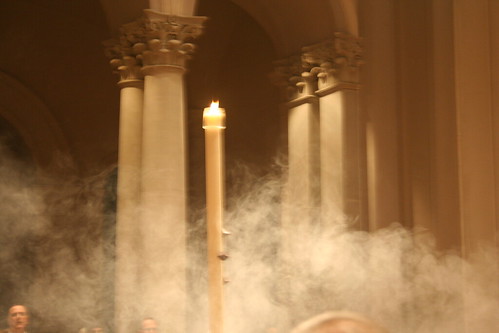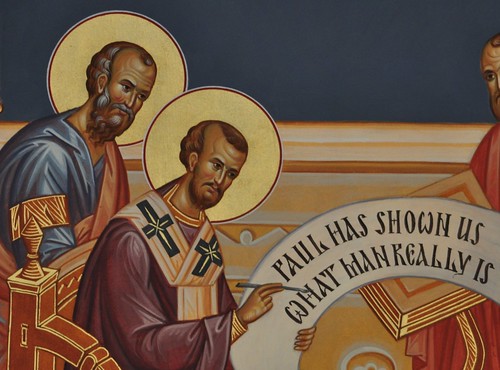
photo by Daniel Kedinger, used under the creative commons license.
check out more photos at: http://www.flickr.com/photos/danielkedinger/
I arrived just before Father Gary was to open the royal doors and begin with "Blessed is the Kingdom...." As is my practice, I venerated the Icon in the Narthex but because Fr Gary was about to start, I didn't want to be caught in the front of the church when the doors opened so I just sat down in the back, waiting for Vespers to begin.
QUESTION: Is it rude of me not to venerate the Icons?
I did notice that one lady came in late and stood in the middle section and waited for Fr Gary to finish incensing the icon in the middle and then she made her rounds around the church venerating the icons while Fr Gary was behind the royal doors and the choir was singing a Psalm. I guess I just feel like I am drawing attention to myself by doing that during the service. Perhaps I am still too Western in my thinking, like this is a "show" I am interrupting.
I also noticed that a lady and two children came in (also late) and after they venerated the icons they lit candles and placed them in the candle stand. I imagine this is cool for kids to do and one of the physical actions of worship that can really help a child to participate.
QUESTION: What is the purpose of lighting the candles?
I would like to know what they represent and is there a difference in understanding between the Orthodox and the Roman Catholic Church regarding candles. Also, is lighting candles only for the initiated or can non-Orthodox light candles as well?
One of the things I love about Orthodox Worship is the incense. To me, the smell takes me to a different world and helps me realize I am in church. It is one of my favorite parts of Vespers to watch Fr Gary incense the icons, then to see him walk to the back of the church and incense the icons there as well. Then he always ends by coming back to the front and incensing the people as well. As Fr Gary is facing them, sending incense their way, the people bow.
QUESTION: Why do people bow when the Priest is incensing them?
I have heard it said that incense represents the prayers of the faithful. (from the book of Revelation). Does it represent anything else. And why exactly are the icons incensed?
I have been going to Vespers for over a year and I have thought about these things but never really taken the time to ask. I suppose when I become a catechumen, that would be a good time to get these questions answered but, I figured with all the knowledgeable people who read this blog, I could get a head start.
Today we remembered St. John Chrysostom. He is the Bishop whose liturgy is celebrated almost every Sunday in the East. Very impressive man. I could use his prayers.
photo by flickr user, bobosh_t, used under the creative commons license.
check out more photos at: http://www.flickr.com/photos/frted/

Jim,
ReplyDeleteI believe I can help you out here. Firstly, this article gives the fancy answer for candles: http://www.orthodox.net/journal/2009-10-26_twelve-meanings-of-candles-based-on-their-properties.html.
But the easy answer is that they also represent our prayers.
As for bowing when we're censed, we bow because the priest is honoring us as icons of God (i.e., people are icons, icons get censed... because it honors them, represents our prayers to them, etc).
And it's not rude of you at all not to venerate icons when you come in late, but it's also not rude to do so, if the priest isn't doing anything special.
Hope that helps!
I would think it's ok for anyone to light candles, but those who are not Orthodox often just don't want to do things like that.
ReplyDeleteAlexandria,
ReplyDeletethanks for the answer....so are we bowing to the priest because he is an icon or because we are acknowledging that we are icons?
I will check out the candles link later today
Maria,
ReplyDeleteI guess I should ask Fr Gary about that...and you are right about non-Orthodox not wanting to do things like that...but, hey, I have been there over a year...I do the crossing myself, venerating Icons and even prostrations so why not this?
You bow to the priest because you're acknowledging that you're an icon, just as he is acknowledging it by censing you.
ReplyDeleteAlexandra,
ReplyDeleteThat is enlightening. It is intuitive to think that since we are bowing to the priest that we are bowing to him, acknowledging him as the Icon.
Hi Jim, no it's not rude of you to not venerate the icons or light candles if you come in late, but then again it's not rude to venerate them either (although best to wait until the area clears out if the priest or deacon is there censing the icons, or reading the Gospel, etc). Don't worry about drawing attention to yourself, as in Orthodoxy the services are much more fluid. For example, if you arrive on time for Divine Liturgy, you'll in fact be interrupting Matins if they serve it, and even if you arrive on time for Matins, the priests have already begun their part of the pre-service preparations and prayers, so that's part of the reason why there is less concern about venerating icons during the service.
ReplyDeleteShane
Aside from partaking of the Eucharist, usually non-Orthodox are welcome to partake in as much of the service as they are comfortable, including lighting candles and venerating icons, although your local parish may have their own custom. For the meaning of candles, as someone already mentioned there are quite a few "spiritual" meanings attributed. However, some of the early church writings characterize it as more practical - at that time and culture, it was common to honor royalty with offerings of incense and candles, so why not honor the King of Kings in a similarly appropriate manner?
ReplyDeleteShane
Shane,
ReplyDeletethanks. I think the idea of a fluid service gets some getting used to. If, during my protestant service, someone got out of his pew and went to the altar rail to pray, in our tradition, it would be "acceptable" because we would have thought he or she was moved by the Holy Spirit but it would have been unusual because most people just wait till the end of the service to go to the altar and pray.
shane,
ReplyDeleteI already venerate the icons...time to move on to candles...:)